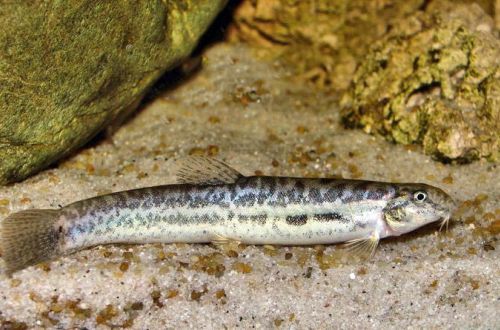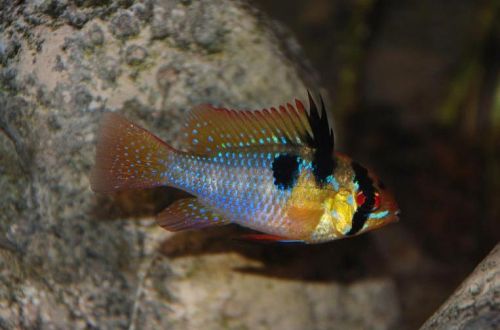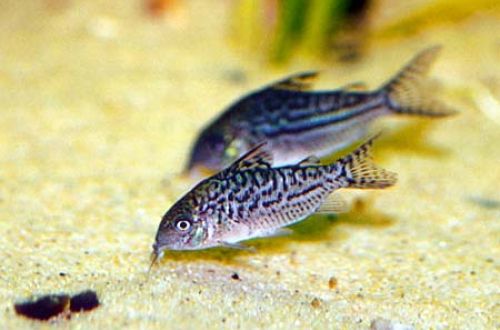
Golets Gunta
Pepper char or Gunta char, scientific name Lepidocephalichthys guntea, belongs to the family Cobitidae (charr). He is considered a popular representative of his group. Although the fish has a modest (nondescript) color, this is offset by ease of maintenance and good compatibility with many freshwater species. May be recommended for beginner aquarists.

Contents
Habitat
Comes from South Asia. It is found in the vast expanses of the Ganges and Brahmaputra river basins in northern India, Nepal, and Bangladesh. Probably inhabits the river systems of Myanmar. It mainly inhabits shallow waters: backwaters of rivers, swamps, floodplain lakes, as well as rice fields. A typical biotope is a shallow body of water with stagnant or slowly moving water. The bottom is covered with a layer of silt, fallen plant remains, numerous snags and tree roots.
Brief information:
- The volume of the aquarium – from 80 liters.
- Temperature – 20-25°C
- Value pH — 6.0–8.0
- Water hardness – soft to medium hard (1-12 dGH)
- Substrate type – soft sandy
- Lighting – subdued
- Brackish water – no
- Water movement – moderate
- The size of the fish is 7–8 cm.
- Nutrition – protein-rich food, sinking
- Temperament – peaceful
- Content in a group of 4 individuals
Description
Adults reach a length of 7-8 cm, although a number of sources indicate that the fish can grow up to 15 cm. The fish has a very elongated body and looks like an eel. The head is small, the eyes are located high on the top of the head. At the mouth there are three pairs of sensitive antennae that help to search for food at the bottom among the silt. The back and sides are gray; a whitish line runs along the body from head to tail. The abdomen is light.
Sexual dimorphism is weakly expressed. Adult females look somewhat larger. In males, the pectoral fins are enlarged and have thickened 7th and 8th rays, forming a structure known as a circular ring.
Food
It feeds at the bottom, sifting through a portion of the soil with its mouth in search of food particles. In nature, the basis of the diet are small invertebrates. In the home aquarium, sinking foods rich in protein should be fed, such as flakes, pellets, as well as fresh or frozen brine shrimp, bloodworms, daphnia and similar products.
Maintenance and care, arrangement of the aquarium
The optimal aquarium size for a group of 4 fish starts at 80 liters. The design focuses on the ground. A sandy or fine gravel substrate should be used to avoid getting stuck in the mouth during feeding. The rest of the decor may include a variety of snags, decorative elements that can serve as shelters. Live rooting plants are not recommended as the bottom is likely to be pitted. But you can place thickets of floating vegetation, which serves as an additional means of shading, which is very useful, since the pepper char prefers dim lighting.
If the design is chosen correctly, then there will be no problems with the content. This is a very hardy and unpretentious fish, able to adapt to various conditions. It is important to provide clean warm water that has the necessary hydrochemical composition of water for this species. Regular maintenance of the aquarium (replacement of water with fresh water, waste disposal, maintenance of equipment) will help maintain biological balance.
Behavior and Compatibility
The Gunta char has a calm and peaceful disposition, gets along well with relatives and other non-aggressive fish of a comparable size. A harmonious community will be obtained with species living in the water column and / or near the surface.
Fish diseases
Finding the fish in a suitable habitat, getting them a balanced diet and free from external threats such as attacks from tankmates is the best guarantee against disease. The appearance of signs of illness can be a signal that there are problems in the content. Usually, bringing the habitat back to normal contributes to self-healing, but if the body of the fish has suffered too much, then medical treatment will be required. Read more about symptoms and treatments in the Aquarium Fish Diseases section.





